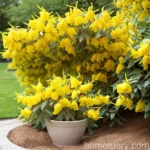Forsythia ‘Meadowlark’: A Comprehensive Guide to Successful Cultivation and Maintenance
Plants are an integral part of our ecosystem, providing us with oxygen, food, and aesthetic pleasure. One plant species that has gained popularity in gardens and landscapes is the forsythia (Forsythia ‘Meadowlark’). In this guide, we will delve into the intricacies of cultivating and caring for the forsythia, covering various aspects such as its cultural requirements, uses, water needs, sunlight preferences, soil and fertilizer requirements, pruning techniques, propagation methods, container gardening, common diseases and pests, and much more.
What is Forsythia ‘Meadowlark’?
Forsythia is a genus of deciduous shrubs belonging to the family Oleaceae. The ‘Meadowlark’ cultivar is renowned for its vibrant yellow flowers, which signify the arrival of spring. Its arching branches adorned with clusters of bright blooms make it a highly sought-after plant for gardens, landscapes, and floral arrangements. This cultivar is particularly valued for its hardiness and adaptability, making it a versatile choice for various settings.
Key Takeaways
Before we delve into the specific aspects of caring for Forsythia ‘Meadowlark’, let’s understand some key takeaways that will guide us through this comprehensive guide. Here are some of the crucial aspects that will be covered in detail:
- Cultural requirements
- Uses
- Water needs
- Sunlight preferences
- Fertilizer requirements
- Soil preferences
- Pruning techniques
- Propagation methods
- Container gardening
- Common diseases
- Common pests
- Botanist’s tips
- Fun facts
- Links to External Resources
Now, let’s delve into each of these aspects to understand how to cultivate and maintain Forsythia ‘Meadowlark’ successfully.
Cultural Requirements
Uses
Forsythia ‘Meadowlark’ serves multiple purposes within the realm of gardening and landscaping. Some of its primary uses include:
- Ornamental Feature: The vibrant yellow flowers of Forsythia ‘Meadowlark’ make it a showstopper in garden beds, borders, and landscapes, especially during the spring season.
- Hedge Plant: With its vigorous growth habit and arching branches, it can be shaped into a visually striking hedge that adds structure and color to garden spaces.
- Cut Flowers: The cut branches of Forsythia ‘Meadowlark’ are used in floral arrangements, bringing the essence of spring indoors.
Water
Forsythia ‘Meadowlark’ exhibits moderate water needs, especially during the establishment phase and dry periods. Proper soil moisture is essential for healthy growth and flowering. However, it’s crucial to avoid waterlogging, which can lead to root rot and other ailments.
Sunlight
This cultivar thrives in full sun to partial shade, requiring a minimum of 6 hours of direct sunlight for optimal growth and prolific flowering. Adequate sunlight ensures robust blooming and healthy, vigorous growth of the plant.
Fertilizer
A balanced, slow-release fertilizer formulated for flowering shrubs can be applied in spring to support the growth and blooming of Forsythia ‘Meadowlark’. It’s essential to follow the application guidelines to prevent overfertilization, which can negatively impact the plant.
Soil
Forsythia ‘Meadowlark’ prefers well-draining soil with a slightly acidic to neutral pH (6.0-7.0). It can adapt to various soil types but thrives in loamy, fertile soils that retain moisture without becoming waterlogged.
Pruning
Effective pruning is essential to maintain the health, shape, and flowering abundance of Forsythia ‘Meadowlark’. This process primarily involves the removal of dead, damaged, or overgrown branches and shaping the plant to enhance its aesthetic appeal.
Propagation
Forsythia ‘Meadowlark’ can be propagated through various methods such as hardwood cuttings, softwood cuttings, and division. Each method offers distinct advantages and is suited to specific circumstances, allowing for the expansion of the plant’s population or sharing it with other gardening enthusiasts.
Container Gardening
The adaptable nature of Forsythia ‘Meadowlark’ makes it well-suited for container gardening. When provided with adequate space, drainage, and nutrients, it can thrive in containers, bringing the beauty of its golden blooms to patios, balconies, and other confined spaces.
Common Diseases and Pests
Like any plant, Forsythia ‘Meadowlark’ is susceptible to certain diseases and pests that can hinder its growth and flowering. Understanding these potential issues and their management is crucial for maintaining the plant’s health and vitality.
Botanist’s Tips
Experts share invaluable tips and insights based on their experiences with Forsythia ‘Meadowlark’, offering unique perspectives and advice for ensuring the best possible care and cultivation of this captivating plant.
Fun Facts
Unravel some interesting and lesser-known facts about Forsythia ‘Meadowlark’, shedding light on its ecological significance, cultural symbolism, and captivating characteristics.
Links to External Resources
For further exploration of Forsythia ‘Meadowlark’ care and cultivation, we’ve curated a list of valuable resources, including reputable websites, publications, and educational materials that provide in-depth knowledge and practical guidance.
Through this comprehensive guide, we aim to equip plant enthusiasts and gardeners with the knowledge and insights essential for nurturing and enjoying the beauty of Forsythia ‘Meadowlark’. By understanding its specific requirements and unique qualities, we can cultivate thriving specimens that enrich our outdoor spaces and connect us with the wonders of the natural world.















